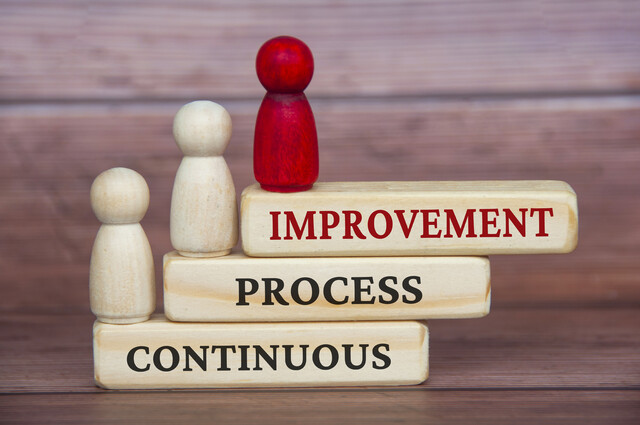Accountability is the primary practice that will make collaboration a success. After all, if no one is held accountable for the practices that emerge from the collaborative group, then collaboration was a complete failure. On the other hand, if the organization is designed and built upon accountability practices, and the organization measures success on accountability or "metrics," then collaboration will be a difficult sell. So what is the answer? A merging of the two practices to create a win-win situation.
Most often, organizations practice accountability through program- and technique-performance measurements. The federal government is notorious for the measuring tools it utilizes to check on a program's performance effectiveness. Look at its educational programs, and all the tests students must take to measure how effective schools are at teaching required curriculum.
What inspires group participation and buy-in that creates collaborative accountability is the leadership's example. References are now made to program metrics, department metrics, organizational metrics, and agency metrics. It's the new "it" or power word on the lips of anyone with any type of authority. Metrics, in essence, is the same thing as accountability. The only difference, if one can be found, is with metrics, there generally is a known or required measuring stick, where accountability leaves the measurement up to the individual leadership.
Issues with collaboration within certain frameworks, when connected with accountability, lie in the fact that many institutions and organizations have legally defined boundaries and frameworks in which they must abide. Some of these organizations, especially public sector, are held accountable for their services within their clearly defined boundaries. Their ratings, money, and reputation are tied to their accountability record. Collaboration tends to cross boundaries and requires various groups to work together � collaborate � to reach a desired goal. While the results may be, and usually are, superior to having the agency work within its defined boundaries, many organizations are reluctant to step into collaboration, because their funding and accountability measurements are tied to their boundaries. For example: An inner-city community center received a federal grant to work with high school students to keep them in school and teach them a trade, so when they graduate from high school, they have marketable job skills. Their by-laws restrict them to the specific zip code, and the government is measuring their success based on the students within this zip code.
The center's officials realize gang influence has filtered into their area and has started recruiting students from the area's high school. The police have approached the center and asked them for collaborating assistance with stifling and shutting down the gang's activities. The problem is the gang is not in their zip code and would require center employees to focus a lot of energy outside their own zip code. The police are sure their assistance will pay huge dividends considering their reputation with students.
Although this scenario is fictitious, the nature of the conundrum is real and happens frequently within organizations trying to collaborate. For collaboration to work, there must be collaborative accountability. For this form of accountability to be a success, there are times when an organization must be willing to change its stance from the "lone ranger" to that of "social superhero." Organizations must quit being silo warehouses with a wealth of talent, knowledge, and ability, and be willing to multiply their output and effectiveness by incorporating the talent, knowledge, and ability of those around them.
The example above not only happens with different agencies attempting to collaborate, but it also happens within organizations. It is not uncommon to see a graphics department unwilling to help advertising on a large campaign, because the ad department has its own artist. Graphics justifies the snub by saying their budget cannot handle the extra cost incurred from the request. What they do not realize is by collaborating, the organization wins from a superb advertising campaign, but many times department leaders have their eyes turned inward and worry about their little castle and empire, instead of the organization as a whole. This type of inward survival technique is to be attributed to an organization's atmosphere, and falls squarely on leadership's shoulders. Leaders must hold themselves accountable for the organization's actions � successes and failures � if the institution is to truly excel. Without collaboration, an organization's full potential will not be met, and leadership must lead the way with selfless decisions.
To reach this type of atmosphere � collaborative accountability � there essentially are four areas that leadership must address: emphasize shared goals and measures that matter for the betterment of the organization, not just one department or individuals; set specific goals, benchmarks, and expected results; do not allow negativity, but encourage a positive environment with the best data, information, and resources; and give timely feedback and be a model example for everyone to follow.
Emphasize shared goals and measures that matter for the betterment of the organization
Leadership has called the group together for a reason. To hold the group accountable for their actions, decisions, and implementation of said decisions, there must be cohesive goals that each and every member has bought into. To achieve buy-in from each individual, leadership must understand the goals, objectives, and feel involved in the processes that reach the goals and objectives.
For this to happen, the following information must be shared with the group:
-
The reason for the group being established
-
The required input, strategies, and contributions the group should be making to the organization as a result of this collaborative effort
-
How the organization and other benefactors will be impacted, and how they are dependent upon the group's contributions
-
The primary resources and assets for group success
This process is a form of "yin and yang," so you now have the items the group needs for collaborative accountability, so now is it is time to list the "yen" and "yang" of group success.
-
Do not skip the time to develop the team cohesiveness, and set their priorities in order to achieve buy-in; do explain roles and take the time to answer questions.
-
With that said, do not immediately dive into the "let's get to work" mode; take time to build team rapport, encourage team goals and highlight the team's purpose.
-
Stifling individual comments, suggestions, and ideas are a no-no; create freedom to speak and encourage ideas, even if they sound silly and off the wall; clarify goals, so ideas are in support of said goals and objectives.
-
Creating "box checkers" and work robots will not get the collaborative team formalized, so avoid this at all costs; ensure the individuals feel they are a part of something bigger than themselves and have the opportunity to truly make a difference.
-
Don't skip the explanation of the "big picture," and the group's role in the grand scheme of things; ensure everyone receives recognition and positive feedback for their efforts.
Set specific goals, benchmarks, and expected results
People begin feeling accountable when they have the impression they are in charge of their own destiny. To this end, accountability feelings are often squelched by a lack of clear goals and objectives as a team. Look at Southwest, one of the few airlines that have been profitable for a number of years.
The airline is known for its simplicity and its simplicity is its main ingredient for success. Leadership set simple goals and laid specific ground rules that are followed by all its members. The airline only uses one type of aircraft, so mechanics, ground, and air crews only need to be trained on one type of aircraft. They do not assign seating, so if a plane has to be changed out at the last minute for mechanical reasons, there is no hassle. Southwest flies direct flights, so there are no hubs, such as Atlanta or other major airports, where congestion exists for aircraft. For this reason, Southwest can turn an aircraft around and have it back in the air in 25 minutes. As the company's leadership notes, no money is made with an aircraft on the ground � it has to be flying to be earning.
How did Southwest achieve buy-in?
-
By not having their people focus only on their task � They understand the complete process, and realize it's a team effort and help where they can.
-
Leadership is not vague with what is expected from its team members, but has outlined clear criteria that must be met from each person.
-
Each member realizes they are not in a vacuum and understands the role of everyone on the team; they encourage each other to fulfill their part, so overall goals are met.
This discussion concerning accountability should be a focal point of a group session. Individuals should uplift and encourage each other, and each person should vocally express their commitment of accountability to the rest of the group. With this type of open commitment from the individuals in the room, collaborative accountability is beginning to take shape.
Step Three
When things are smooth, it is not hard to locate someone to take credit for the success. In fact, morale is high and ideas, enthusiasm, slaps on the back, smiles, and encouragement run rampant throughout the group. But what happens when there's a hiccup and the situation takes a nose dive? What if planned objectives are not being met? What if it looks like the group will not meet its deadline and planned goals will not be achieved?
This is when the true accountability of each individual within the team will rise to the surface. This is where the true leader rises to the surface and leads the way to being accountable. A true leader is the one who steps up and does not allow finger pointing and heads to be hung low, because of the appearance of failure. A real leader does not blame the group, but steps up and accepts full responsibility for any perceived failures. A realistic leader realizes that people tend to hide behind others when things are riding in the red, but back out from behind others when numbers are in the black. Positivity breeds spotlights, while negativity buries people's heads in the sand.
When failure is in the air, the leader must hold the group's banner high and march to a different beat from everyone else. He must show success matters, and the team's activities still count, and all goals are within reach if everyone digs in. This is where the leader should halt all the blame games and remind everyone there is strength in adversity, so live, learn, and lead each other to success.
Forgiveness for any mistakes is the norm of the moment and the leader should explain mistakes happen and it's not the end of the world as long as lessons are learned and the group grows from the experience. The focus that should be set within the group in this type of setting should be, "okay team, what can we do to get us back on track and how are we going to help each other make our objectives?"
Step Four
Carlos Ghosn, (his last name rhymes with cone) leads two Fortune Global 500 companies � Nissan and Renault � and the number one automaker in Russia, AutoVaz, which makes the Lada, the country's top-selling automobile. Incredibly, he runs three automakers located in three different countries, with three different cultures and languages, and is responsible for 10 percent of the world's auto sales, creating about $140 billion in 2014.
What sets Ghosn apart is this: When he took control of the two auto giants, negativity and finger pointing dominated their environments. Profits were plummeting, and their future looked dismal. He turned the auto giants around by setting the example as a responsible leader. He publicly declared he would step down and resign, if Nissan did not meet its planned objectives. Nissan looked to its new leader for inspiration and he delivered. In turn, Nissan achieved its outlined objectives one year early.
What inspires group participation and buy-in that creates collaborative accountability is the leadership's example. Leadership sets the group's and organization's tone through their pattern of speech and work habits. To get a team to accept responsibility for their actions, and to accept accountability for their decisions, leadership must lead by example and be the first to accept accountability for the actions of the organization.






















